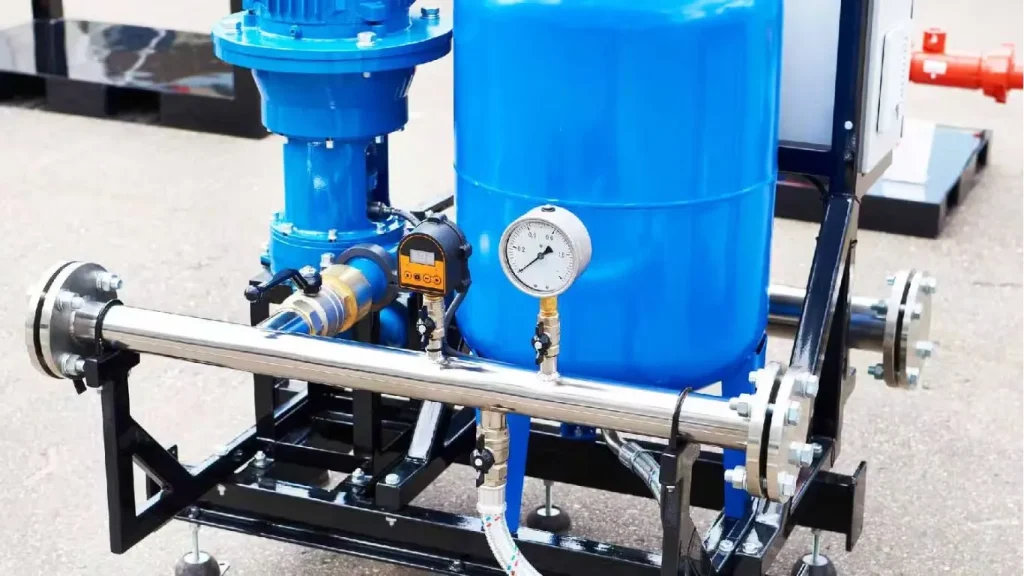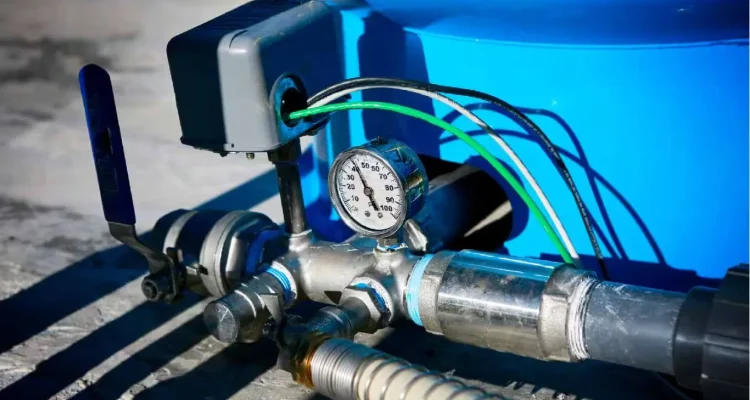Introduction
Choosing the right size pressure tank for your water system is crucial. It’s not just about ensuring you have enough water on hand, but also about maintaining the health and efficiency of your pump. So, how do you figure out what size pressure tank you need? Let’s dive into the details!

Understanding Pressure Tanks
What is a Pressure Tank?
A pressure tank is a component of a well water system that stores water under pressure. When you turn on a tap, water is pushed out by the pressure in the tank rather than the pump turning on each time you need water. This helps to prolong the life of your pump.
How Pressure Tanks Work
Pressure tanks work by using air pressure to push water out. Inside the tank, there’s a bladder or diaphragm that separates the air from the water. As the tank fills with water, the air is compressed, creating pressure. When the pressure reaches a certain point, the pump turns off. When you use water, the pressure drops and the pump turns on again to refill the tank.
Types of Pressure Tanks
Diaphragm Pressure Tanks
These tanks have a diaphragm that separates the water from the air. They are known for their durability and consistent performance.
Bladder Pressure Tanks
Bladder tanks use a bladder to separate the air and water. They are effective in preventing waterlogging, which is a common issue in older tank designs.
Air-Over-Water Pressure Tanks
This older design doesn’t use a bladder or diaphragm. Instead, the air and water mix inside the tank. These tanks require more maintenance to ensure the air charge is maintained.
Factors to Consider When Choosing a Pressure Tank
Water Demand
Consider the amount of water your household uses daily. This includes usage for showers, laundry, dishes, and outdoor activities.
Pump Flow Rate
The flow rate of your pump (measured in gallons per minute or GPM) will help determine the size of the tank you need. The higher the flow rate, the larger the tank required.
Pressure Settings
Your system’s pressure settings (cut-in and cut-out pressure) will influence the tank size. Typical settings are 30/50 or 40/60 PSI.
Calculating the Right Pressure Tank Size
Determining Water Usage
Estimate your household’s daily water usage. A typical household uses about 100 gallons per day per person.
Calculating Drawdown Capacity
Drawdown capacity is the amount of water a tank can deliver between the pump turning on and off. It depends on the tank size and pressure settings. Use the formula:
Drawdown Capacity=Tank Volume×(Cut-Out Pressure−Cut-In PressureCut-Out Pressure)\text{Drawdown Capacity} = \text{Tank Volume} \times \left( \frac{\text{Cut-Out Pressure} – \text{Cut-In Pressure}}{\text{Cut-Out Pressure}} \right)Drawdown Capacity=Tank Volume×(Cut-Out PressureCut-Out Pressure−Cut-In Pressure)
Matching Tank Size to Pump
Ensure the tank can handle the pump’s flow rate without causing rapid cycling. A larger tank can accommodate more water, reducing the frequency of pump cycles.
Household Water Needs
Average Water Usage for a Household
A family of four typically uses around 400 gallons of water per day. This includes all household activities and appliances.
Peak Water Demand Scenarios
Consider peak usage times, such as mornings and evenings, when water demand is highest. Ensure your tank can meet these needs without straining the pump.
Pressure Tank Sizing for Different Applications
Residential Homes
For most homes, a pressure tank in the range of 40-60 gallons is sufficient. Larger homes with higher water demands may require an 80-gallon tank.
Agricultural Uses
Farms and agricultural operations often need larger tanks, ranging from 80-120 gallons, to meet the high water demands of irrigation and livestock.
Commercial Applications
Commercial buildings and businesses may require even larger tanks, depending on their specific water usage patterns and peak demand periods.
Common Pressure Tank Sizes
Small Tanks (20-40 Gallons)
Suitable for small homes or cabins with low water usage.
Medium Tanks (40-80 Gallons)
Ideal for average-sized homes and families with moderate water needs.
Large Tanks (80+ Gallons)
Necessary for large homes, farms, or commercial properties with high water demands.
Installation and Maintenance Tips
Proper Installation Techniques
Ensure the tank is installed on a solid, level surface. Connect the tank to the system following manufacturer instructions and local codes.
Regular Maintenance Practices
Check the tank’s pressure regularly and ensure there are no leaks. Inspect the bladder or diaphragm for signs of wear or damage.
Advantages of Choosing the Right Size
Improved Water Pressure
A properly sized tank maintains consistent water pressure, enhancing comfort and convenience.
Increased Pump Longevity
Reducing the frequency of pump cycles extends the life of your pump, saving you money on repairs and replacements.
Enhanced System Efficiency
An appropriately sized tank ensures your system operates efficiently, reducing energy costs and water waste.
Potential Problems with Incorrect Tank Sizing
Frequent Pump Cycling
A tank that’s too small will cause the pump to cycle on and off more frequently, leading to premature wear.
Inconsistent Water Pressure
An incorrectly sized tank can result in fluctuating water pressure, affecting your household activities.
Premature Pump Failure
Constant cycling and strain on the pump can lead to early failure, requiring costly repairs or replacements.
Energy Efficiency Considerations
Impact of Tank Size on Energy Use
A properly sized tank reduces the workload on the pump, leading to lower energy consumption.
Cost Savings with Proper Sizing
Investing in the right tank size can lead to significant savings on your energy bills and maintenance costs over time.
Selecting a Quality Pressure Tank
Trusted Brands
Choose tanks from reputable manufacturers known for their quality and reliability.
Warranty and Customer Support
Look for tanks that come with a good warranty and responsive customer support for peace of mind.
FAQs What Size Pressure Tank Do I Need?
How often should I replace my pressure tank?
Pressure tanks typically last between 5 to 15 years, depending on the quality and maintenance. Regular checks can help extend its lifespan.
What is the lifespan of a pressure tank?
The average lifespan of a pressure tank is around 10 years, but this can vary based on usage and maintenance.
Can I install a pressure tank myself?
While it’s possible to install a pressure tank yourself, it’s recommended to hire a professional to ensure proper installation and avoid potential issues.
How do I know if my pressure tank is failing?
Signs of a failing pressure tank include fluctuating water pressure, frequent pump cycling, and visible leaks.
What are the signs of a waterlogged pressure tank?
A waterlogged pressure tank will cause the pump to run continuously or cycle rapidly. You might also notice reduced water pressure and odd noises from the tank.
Conclusion
Choosing the right size pressure tank is essential for maintaining a reliable and efficient water system. By considering your water usage, pump flow rate, and pressure settings, you can select a tank that meets your needs and ensures the longevity of your pump. Remember, a well-sized pressure tank not only improves water pressure but also saves energy and reduces maintenance costs.


Congratulation!